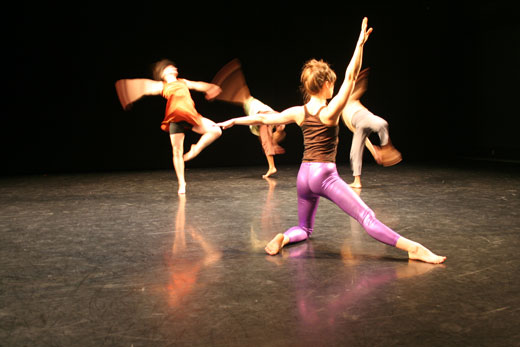Greg Catellier, senior lecturer in dance, and the group of collaborators who make up Catellier Dance Projects (CDP) have spent the past few years pushing the boundaries of choreography and performance.
With 2011's "tempo, a non-fiction dance performance" and last year's "…the final frontier," Catellier combined personal anecdotes, multi-media storytelling, and audience immersion to produce works of modern dance. On Jan. 24-26, Catellier Dance Projects presents "E," the third in a series of four works that explores the element of energy.
Catellier discusses the creative and collaborative process:
Catellier Dance Projects has embarked on a multi-year creative project composed of four works examining the elements of dance. How did the idea for this series come about?
The first piece "tempo, a non-fiction dance performance" was originally to be a stand-alone piece. Then I noticed that a lot of New York choreographers were doing a series of works and I thought that was pretty silly. Things like, "This is the fifth piece in a series of seven about organic farming and ontology." I began to joke about making a series of dances based on the elements of dance just to be "cool." As I joked with my colleagues in the dance program and other folks in the dance community it became clear that it could actually be an interesting series. All the elements -- time, space, energy and the body -- are such massive subjects that they allow for multiple avenues of investigation. I like how these subjects can be viewed objectively or scientifically and then be turned to something personal or interpersonal.
"E," the third work in the series, examines energy. How did you approach the topic in your work?
In "E" we have been looking at potential energy, electrical energy but also emotional energy. If one has ever been depressed, you know that emotion requires energy. For myself there is always a wind-up when someone asks, "How are you doing?" I have to muster enough energy to say "great," and sound like I mean it.
"E" follows last year's "…the final frontier" and 2011's "tempo, a non-fiction dance performance." How have the experiences of creating the previous two pieces informed your examination of energy with "E"?
I have learned much about my process, audience expectations, and slowly, very slowly, how to ask for help. For me the process needs to be intellectually stimulating, fun and at some point take over all aspects of my life. I'm at that point now.
I think it is important to give the audience many different points of entry to the work. Some people really hone in on the movement; others engage with video work; still others need an emotional hook. Sometimes audience members at a dance performance spend their whole time trying to make sense of what they are watching and then leave feeling as if they "didn't get it." With this series of works, I have been telling the audience directly what the piece deals with. This allows them to relax and make connections to what they are experiencing, rather than trying to just figure out what it's about.
With "E," you will once again be collaborating with media artist Jeff Curtis. What is he bringing to the work ?
Jeff has created a video for "E." A live video feed will also play a part in "E." He brings such intellectual and visual knowledge to the work.
And [Emory College student] Ari Shaw–Faber has been working with CDP for the past three years as a technical advisor. Ari has been an invaluable asset to Catellier Dance Projects often playing a critical role by creating technical systems that allow for the full realization of design elements. For "E," Ari is using a computer program called "Isadora" to manipulate video in real time. Students like Ari make creative research at Emory a joy.
Next up, CDP will finish the series by taking a look at the body. Is it too early to ask how you plan to tackle what may be the most fundamental element of dance?
We don't have a date yet, but I have been thinking about the "body" piece. For one, I'm looking for a versatile, well-trained a cappella group. Music for the body should come from the body. Also, isn't there a pill you can swallow that has a little camera in it so you can see inside the digestive tract? I'd like to get my hands on one of those. Generally, I would be interested in collaborating with someone in the sciences.

